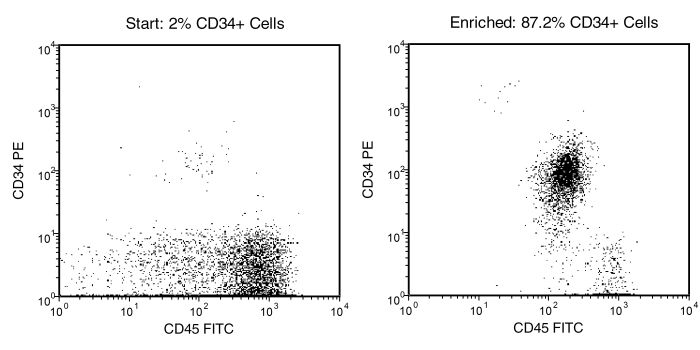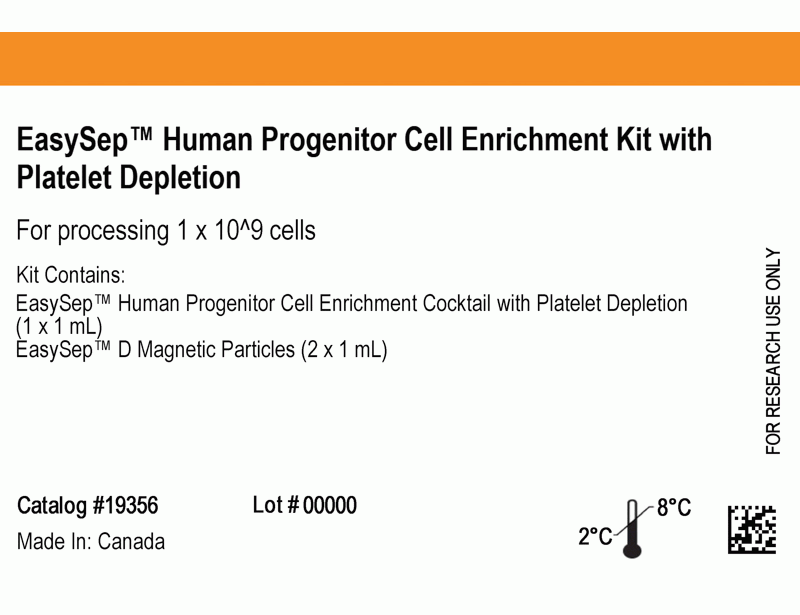EasySep™ Human Progenitor Cell Enrichment Kit with Platelet Depletion
Immunomagnetic negative selection kit
概要
The EasySep™ Human Progenitor Cell Enrichment Kit with Platelet Depletion is designed to isolate hematopoietic progenitor cells from fresh or previously frozen cord blood and other cell preparations that contain large numbers of platelets by negative selection. Unwanted cells are targeted for removal with Tetrameric Antibody Complexes recognizing CD2, CD3, CD11b, CD11c, CD14, CD16, CD19, CD24, CD56, CD61, CD66b, glycophorin A and dextran-coated magnetic particles. The labeled cells are separated using an EasySep™ magnet without the use of columns. Desired cells are poured off into a new tube.
Advantages
• Fast, easy-to-use and column-free
• Up to 75% purity
• Isolated cells are untouched
• Up to 75% purity
• Isolated cells are untouched
Components
- EasySep™ Human Progenitor Cell Enrichment Kit with Platelet Depletion (Catalog #19356)
- EasySep™ Human Progenitor Cell Enrichment Cocktail with Platelet Depletion, 1 mL
- EasySep™ Magnetic Particles, 2 x 1 mL
- RoboSep™ Human Progenitor Enrichment with Platelet Depletion (Catalog #19356RF)
- EasySep™ Human Progenitor Cell Enrichment Cocktail with Platelet Depletion, 1 mL
- EasySep™ Magnetic Particles, 2 x 1 mL
- RoboSep™ Buffer (Catalog #20104)
- RoboSep™ Filter Tips (Catalog #20125)
Magnet Compatibility
• EasySep™ Magnet (Catalog #18000)
• “The Big Easy” EasySep™ Magnet (Catalog #18001)
• RoboSep™-S (Catalog #21000)
Subtype
Cell Isolation Kits
Cell Type
Hematopoietic Stem and Progenitor Cells
Species
Human
Sample Source
Cord Blood, PBMC
Selection Method
Negative
Application
Cell Isolation
Brand
EasySep, RoboSep
Area of Interest
Immunology, Stem Cell Biology
技术资料
| Document Type | 产品名称 | Catalog # | Lot # | 语言 |
|---|---|---|---|---|
| Product Information Sheet | EasySep™ Human Progenitor Cell Enrichment Kit with Platelet Depletion | 19356 | All | English |
| Product Information Sheet | RoboSep™ Human Progenitor Enrichment with Platelet Depletion | 19356RF | All | English |
| Safety Data Sheet 1 | EasySep™ Human Progenitor Cell Enrichment Kit with Platelet Depletion | 19356 | All | English |
| Safety Data Sheet 2 | EasySep™ Human Progenitor Cell Enrichment Kit with Platelet Depletion | 19356 | All | English |
| Safety Data Sheet 1 | RoboSep™ Human Progenitor Enrichment with Platelet Depletion | 19356RF | All | English |
| Safety Data Sheet 2 | RoboSep™ Human Progenitor Enrichment with Platelet Depletion | 19356RF | All | English |
| Safety Data Sheet 3 | RoboSep™ Human Progenitor Enrichment with Platelet Depletion | 19356RF | All | English |
数据及文献
Data

Figure 1. Typical EasySep™ Human Progenitor Cell Enrichment Kit with Platelet Depletion Profile
Starting with nucleated cells, the CD34+ cell content of the enriched fraction typically ranges from 50 - 75%, depending on the quality of the start sample. Note: CD34+ enrichment is dependent on the frequency of CD34+ cells in the start sample, which is variable between cord blood samples. Use of poor quality cord blood or frozen samples may result in lower CD34+ cell content of the enriched fraction.
Publications (2)
Blood 2020 jun
Activation of the receptor tyrosine kinase, RET, improves long-term hematopoietic stem cell outgrowth and potency.
Abstract
Abstract
Expansion of Human Hematopoietic Stem Cells (HSCs) is a rapidly advancing field showing great promise for clinical applications. Recent evidence has implicated the nervous system and glial family ligands (GFLs) as potential drivers of hematopoietic survival and self-renewal in the bone marrow niche, but how to apply this to HSC maintenance and expansion is yet to be explored. We demonstrate a role for the GFL receptor, RET, at the cell surface of HSCs, in mediating sustained cellular growth, resistance to stress and improved cell survival throughout in vitro expansion. HSCs treated with the key RET ligand/co-receptor complex, GDNF/GFRa1, show improved progenitor function at primary transplantation and improved long-term HSC function at secondary transplantation. Finally, we demonstrate that RET drives a multi-faceted intracellular signalling pathway, including key signalling intermediates AKT, ERK1/2, NFkB and p53, responsible for a wide range of cellular and genetic responses which improve cell growth and survival under culture conditions.
Oncogene 2019 jan
Spironolactone inhibits the growth of cancer stem cells by impairing DNA damage response.
Abstract
Abstract
The cancer stem cell (CSC) model suggests that a subpopulation of cells within the tumor, the CSCs, is responsible for cancer relapse and metastasis formation. CSCs hold unique characteristics, such as self-renewal, differentiation abilities, and resistance to chemotherapy, raising the need for discovering drugs that target CSCs. Previously we have found that the antihypertensive drug spironolactone impairs DNA damage response in cancer cells. Here we show that spironolactone, apart from inhibiting cancerous cell growth, is also highly toxic to CSCs. Notably, we demonstrate that CSCs have high basal levels of DNA double-strand breaks (DSBs). Mechanistically, we reveal that spironolactone does not damage the DNA but impairs DSB repair and induces apoptosis in cancer cells and CSCs while sparing healthy cells. In vivo, spironolactone treatment reduced the size and CSC content of tumors. Overall, we suggest spironolactone as an anticancer reagent, toxic to both cancer cells and, particularly to, CSCs.



